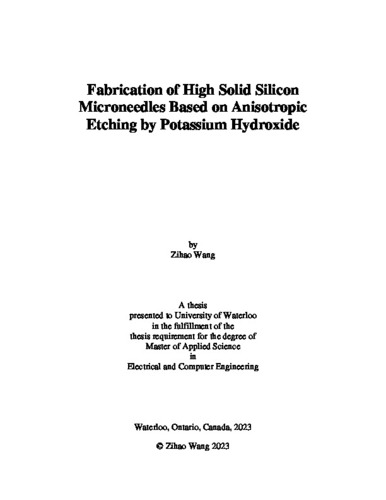| dc.description.abstract | This thesis presents the research on the high solid silicon microneedles fabrication based on KOH anisotropic etching, aiming at finding a controllable way to fabricate 500 μm high microneedles with good height uniformity and tip sharpness. During this research, 200nm low-stress LPCVD SiNx is used as KOH etching mask; mask shape is square-shaped with its side along <100> direction of silicon wafer; wet etching is done in 29wt% KOH solution at 79oC.
In the introduction part, a general introduction of modern nanotechnology and microneedles is presented. The nanofabrication techniques that related to microneedles fabrication such as thin film deposition, photolithography, reactive ion etching, and KOH anisotropic etching are introduced for better comprehension of this research. In the experiments part, the fabrication process of microneedles is explained step by step, including SiNx deposition and patterning, KOH wet etching, isotropic reactive ion etching using SF6, and scanning electron microscope characterization. In the discussion part, the geometry of microneedles is studied by SEM characterization. The microneedle shape is determined as an octagonal pyramid, and its sidewall is determined as (311) plane. The aspect ratio of microneedle is 1.414. Then the growth model of microneedles in KOH etching is established. The maximum height of microneedle, obtained right after mask falling off, is positively proportional to its mask size; the real-time height of microneedle has a positive correlation during growth then, after mask falling off, a negative correlation during overetching with time. The height growth rate is 72.5 μm/h, while the height dropping rate during over-etching is 400 μm/h. Finally, an additional step of reactive ion etching by using SF6 gas is introduced following KOH etching before mask falling off to improve the uniformity of microneedles height, which also contributes to improve the tip sharpness. By replacing the inevitable over-etching using KOH with the SF6 RIE step, the standard deviation of microneedles height decreased from 20.50 μm to 11.12 μm; the tip apex diameter decreased from 6.92 μm to 2.71 μm. | en |

